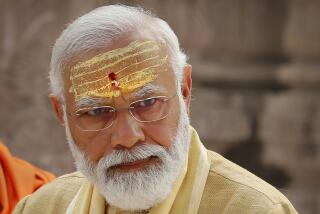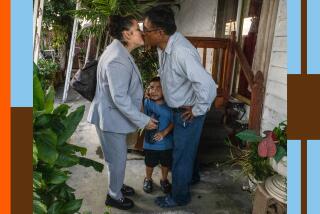My Turn: A woman and a girl, united by cancer and courage
When my 14-year-old niece Lindsey died last year, my friend Mary took it personally. Although separated by decades, Mary Schnack and Lindsey Stewart shared a common menace: cancer.
Lindsey was diagnosed at age 10 with medulloblastoma, brain cancer. The most common malignant brain tumor in children, it is highly invasive and often fatal. Lindsey died two months short of her 15th birthday.
Mary had been diagnosed at age 40 with endometrial stromal sarcoma. ESS is rare, difficult to treat and often recurs. The typical survival time is three years.
When Mary heard about Lindsey, she reached out. She sent gifts for birthdays, gifts for Christmas, sometimes notes from her travels. When Lindsey’s church in Grinnell, Iowa, printed T-shirts emblazoned with “Fight like Lindsey” and “Lindsey’s Team,” Mary wanted one.
Lindsey had surgery, radiation and chemotherapy, then went into remission. She decided she’d go to medical school.
“She could have done it, too,” my brother said. “She was so smart.”
Doctors warned that the treatments could impair her intelligence, but Lindsey continued to get straight A’s.
A year later, in sixth grade, Lindsey wrote an essay in which she described the day of her diagnosis. She hadn’t wanted to go to the hospital, even though her headaches were so severe she often vomited and cried. She knew something was very wrong and she was afraid to find out what. But that Saturday in 2006, she’d started losing her balance, so her parents took her to the ER.
The doctor wanted to do a CAT scan.
“I’m not a betting kind of man,” he said, “but I bet you a nickel that the CAT scan will be fine.”
After the test, they wheeled Lindsey back to the room and took her parents into the hall. They were gone for what seemed like forever.
Finally, her dad came in alone.
“Where is Mom?” Lindsey asked.
He didn’t answer. He just sat at her bedside, clasped his hands and began to cry.
“I knew something was wrong,” Lindsey wrote, “because Dad never cries.”
Slowly, he started to speak: “They said there is a tumor in the back of your head.”
“What does that mean? Am I going to be OK?”
“I kept crying and saying over and over again, ‘I can’t do this!,’” she wrote in her essay. “At the time, I never thought I could. I calmed down and my mom and I rode in an ambulance all the way to Iowa City…. The whole way down, I kept telling my mom it was going to be OK. Little did I know how much it would affect my whole life.”
A year earlier, during treatments, her mother had said, “Lindsey, you know if I had a magic wand I could wave to take this all away, I would do it. You know that, don’t you?”
“Oh, Mom, I wouldn’t want you to take this away,” Lindsey replied. “It’s because of this that I know how precious life is. ... I’ll never take anything for granted ever again.”
---
Mary, too, knew how precious life is.
She and I graduated from the University of Iowa together. Mary became a journalist, freelance writer, rape-crisis counselor, spokeswoman for a Los Angeles-area hospital, then a media consultant and entrepreneur.
Through her diagnosis and treatments, she continued to work and travel. She created a company that sells crafts made by women from impoverished countries; the idea is to help them earn a living, which helps them gain the power to control their own lives.
She was divorced, and she reared her special-needs daughter, Erika, now 29, virtually alone.
Her initial diagnosis came in 1996 after what had seemed to be a routine hysterectomy. Fibroids, the doctors thought — but they also found cancer.
Mary and her doctors hoped that the surgery had caught all the cancer cells. Chemotherapy isn’t particularly effective against ESS, they told her, and they wanted to keep radiation in reserve. She had radiation three years later, when the cancer recurred. It proved ineffective. She was treated with hormone therapy, which seemed to buy her time.
Cancer eventually became part of Mary’s routine. She resigned herself to its return every two or three years and built up a prodigious amount of scar tissue from all the surgeries. Yet she kept living, loving, traveling and thriving. She spoke to groups about her cancer and incorporated what she’d learned from it into her business, creating a motivational training program.
And her early surgeries weren’t that difficult — her surgeon at Stanford likened removing the cancer to popping a nut out of a shell.
“I’ve learned this isn’t going to kill me,” she told me once. But she’d also dreamed that she wouldn’t live past 55.
In January 2011, Mary had her seventh surgery. That one was more difficult; the cancer had invaded a vein that fed her left leg. The operation was successful, but it took a toll.
“I don’t want to be amazing,” she blogged that month. “I don’t want to be strong. I don’t want to be an inspiration to others. What I want is — I just don’t want to do this anymore.”
When Lindsey died two months later, on March 4, Mary was devastated. Soon after, she felt something wasn’t right in her abdomen. She hoped it was just scar tissue, but doctors confirmed the cancer had returned.
Mary didn’t want surgery immediately; she’d just recovered from her seventh operation and she needed to earn money for medical bills. When she had the operation — her eighth — on the Tuesday after Thanksgiving, the cancer no longer popped out like a nut. Doctors couldn’t remove all of it. They had to take part of her abdominal wall and replace it with mesh, which they warned was prone to infection.
Recovery came haltingly this time. Even morphine didn’t seem to help with the pain. Then she got pneumonia. I decided I’d better go see her in the hospital at Stanford in case she never got out.
When I visited Dec. 9, she looked and sounded great. Doctors had told her she probably would be released within days. The typical Mary had resurfaced — optimistic and looking to the future.
The next day, I returned to Los Angeles. I went to a holiday party that night, taking a tiny beaded purse with no room for my cellphone.
When I got home, I found two texts Mary had sent at 10:18 p.m.:
“What a special afternoon. It all went downhill from there. Back into surgery again now. ... They asked this morning for a chaplain contact and this afternoon for me to get support people here. I love you so much.”
She had developed sepsis.
Mary didn’t expect to survive the surgery — yet she did. She needed several more operations in the next week to clean out the wound, and powerful antibiotics to resolve the infection.
Doctors replaced the mesh with a porcine graft and essentially left the wound open, attached to a vacuum device that suctioned out toxins from a leaky bowel. She’d need a skin graft eventually if she were ever to heal.
I made plans to visit, but she said not to come, that she’d soon get out and come to Southern California.
But on Jan. 2, she had a stroke, which took her sight. On Jan. 4, she had another one, which left her paralyzed on the left side. By the time I saw her, she’d lost most of her ability to speak. Doctors told her that she was terminal, that she wouldn’t survive another surgery, and that the cancer was growing again.
Although she could barely string three or four words together, she summoned the will to tell her daughter, “Erika, I love you so much. I’m going to take care of you.”
“Mom, we’re going to take care of you,” Erika replied. “You’re the one who’s in that hospital bed.”
Mary went for hospice care to Sedona, Ariz., where her many friends teamed up to care for her, sit with her, read cards and letters to her. One was from her mother, 90 and too fragile to travel from Iowa to her daughter’s bedside.
Sedona’s annual film festival in February included a documentary: “When Cancer Returns 8x: The Mary Schnack Story.”
The filmmaker, Karen Frye of Phoenix, had begun documenting Mary’s struggle in 2010. As the premiere approached, Mary insisted they have a film party.
Erika left the room as the screening began. “I don’t want to see it,” she said.
But she could hear — and on the film, she heard Mary laugh. Erika came running back into the room, pointed at the screen and said, “That’s my mom! That’s my mom!”
The next day, Mary slowed down.
“Monday evening found just myself and my husband in the bedroom with Mary,” wrote her friend and primary caregiver, Bobbie Surber. “I was holding her hand when all of a sudden for the very first time Mary was not holding my hand in return. I just knew she was leaving us.
“As we both told her how much we loved her, how much she meant to so many around the world and how we would all care for Erika, Mary started to slow her breathing. We said the Lord’s Prayer and before we knew it, Mary had passed. … Mary left this world knowing she was deeply loved.”
One of Mary’s friends left this note on Mary’s Facebook page the next night:
“Mary, I just went to the Surbers’ house to take them some eggplant parmigiana. No one answered so I let myself in, put the platter in the fridge and went to kiss you goodnight and tell you I’d be there tomorrow night to read to you.
“I had not checked my emails. The bed was empty and Erika courageously told me you were gone. I am writing here to send you my love and that kiss goodnight. … Safe journey back home.”
Mary died on Feb. 20, 2012, at 55.
Last Christmas, someone named a star for Lindsey. Her parents wondered who had been so thoughtful. They asked relatives. They asked around town. They asked at the church. We posted a query on Lindsey’s memorial Facebook page. No one came forward.
The other night, as I told my brother about Mary’s death, I wondered: Did Mary name that star? It was exactly the sort of thing she’d do.
Now I’ll never know.
I do know that when I look at the stars, I’ll see Lindsey and Mary together.
More to Read
Start your day right
Sign up for Essential California for news, features and recommendations from the L.A. Times and beyond in your inbox six days a week.
You may occasionally receive promotional content from the Los Angeles Times.






